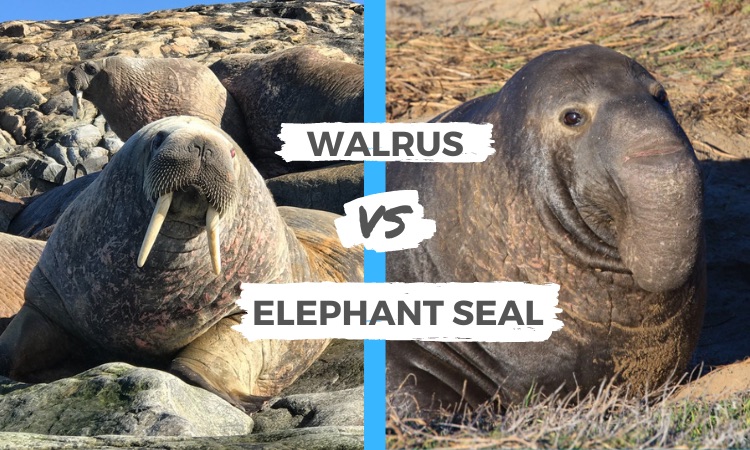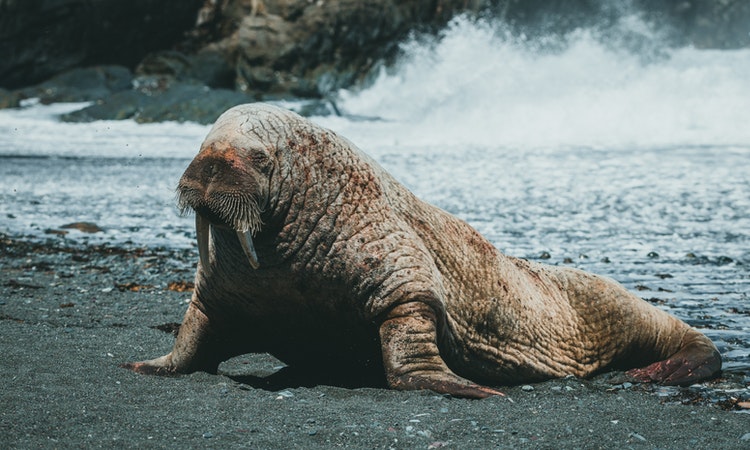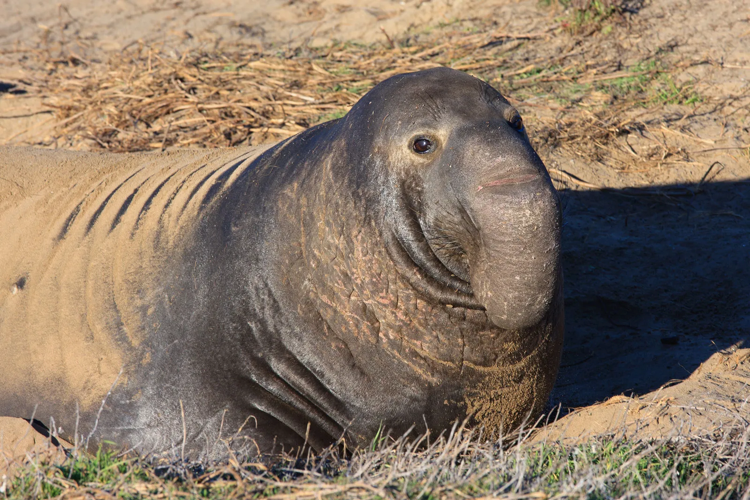You may be wondering what the distinctions are between a walrus vs elephant seal. Both of these animals are regarded as rulers of the sea given their size.
Although they’re both kings of the seas when it comes to size, you might wonder what the differences are between them. Their differing appearance and size variations frequently distinguish one from the other.
In this post, we’ll go through all of these variations, including the many habitats and likes that both walruses and elephants have. Walruses are far from elephant seals in terms of their appearance, behaviour, lifestyle, and even diet! Read on to learn more.

Walrus and Elephant Seal Comparisons
There are several significant distinctions between a walrus and an elephant seal, similar to the walrus vs seal. Walruses belong to the Odobenus genus, whereas elephant seals are part of the Mirounga species.
Elephant seals are much bigger than walruses, and elephant seals don’t have distinct tusks. The geographical distribution of walruses and elephant seals is also quite different.
Walruses reside in the Arctic regions and elephant seals are found throughout the world in a variety of settings. Let’s take a look at some of these differences in detail now.
Walrus vs Elephant Seal: Genus
The primary difference between a walrus and an elephant seal is their habitat and species classifications.
Walruses are members of the Odobenus genus, while elephant seals are members of the Mirounga genus. Even though they may be difficult to distinguish at first glance, they are truly different sea creatures from one another due to their genus class.

The Habitats of the two Species
Another distinction between them are their geographical locations and where you can find them in the wild. Walruses dwell in the Arctic Circle’s chilly seas.
Elephant seals are found all around the world in a variety of habitats. While it’s conceivable for the two species to come into contact in nature, it isn’t as common as you would believe.
The walrus has been important in many indigenous Arctic communities’ cultures, who have hunted the walrus for its meat, fat, skin, tusks, and bone.
For a long time during the Victorian ear and early twentieth centuries, walruses were subjected to extensive hunting and slaughter for their blubber, walrus ivory, and flesh. The walrus population plummeted dramatically all around the Arctic.
Their number has risen somewhat since then, although the populations of Atlantic and Laptev walruses remain fractured and low, as compared to before human interference. Elephant seals have not endured the same level of hunting over the preceding centuries.
Walrus vs Elephant Seal: Appearance
The elephant seal’s skin is covered in coarse hair, while the walrus has a sparse covering of coarse hair. Elephant seals do not have tusks, but walruses always do.
Although walruses and elephant seals have whiskers, those on a walrus are far more distinct. The elephant seal’s unique snout is unlike any other, whereas walruses have standard flat snout.
Both of these animals are better adapted to life in the water than on land. In terms of mobility, walruses have a slight edge over elephant seals.
Elephant seals are unable to use their back flippers, but they can utilize their rear flippers to propel them on land. They drag their bodies behind using only their front flippers, whereas walruses have a little more agility and speed on land.
Size Difference
While both walruses and elephant seals are quite enormous, elephant seals outweigh walruses by a long shot. When compared to walruses, elephant seals are larger in every department.
Walruses, for example, can measure up to 7-12 feet long and weigh 800-4,000 pounds. Elephant seals are 10-16 feet long and may weigh as much as 2,000-6,000 pounds!
Lifespan
Another difference between a walrus vs elephant seal is their overall life span. Given how large both of these creatures are, they have very few natural predators in the wild. However, the superior size of the elephant seal could explain its shorter lifespan relative to the walrus.
The typical elephant seal lives for about 20 years in the wild, although walruses can live to be up to the age of 50. The larger size of elephant seals is presumably linked to their shorter lifespan. They are also less likely to defend themselves than walruses.
Walruses are highly aggressive, and they have strong tusks that they may use to defend themselves. Humans are the most serious threats to walruses. Killer whales are the greatest threat to elephant seals.

The Diet of Walrus and Elephant Seal:
The walrus has a broad and adaptable diet that includes more than 60 species of sea creatures, including shrimp, crabs, tube worms, soft corals, tunicates, sea cucumbers, and various mollusks. They also eat certain types of slow-moving fish.
In addition, it thrives on benthic bivalve mollusks, particularly clams, for which it searches and identifies prey with its sensitive vibrissae and cleans the murky bottoms using jets of water and active flipper movements.
The walrus uses its large lips to seal tightly around the organism and pull in its piston-like tongue swiftly, creating a vacuum. The walrus’s palate is exceptionally vaulted, allowing for strong suction. Benthic invertebrates account for 97 percent of the Pacific walrus’s diet.
Aside from the numerous creatures that the walrus actually consumes, its foraging has significant benthic consequences. It disturbs the seafloor, releasing nutrients into the water column and promoting the mixing and movement of many organisms while also increasing patchiness in the benthos.
In the Pacific, seals have been observed in a large number of walrus stomachs. However, the role of seals in the walrus diet is debatable. Up to a 440-pound bearded seal, there have been isolated observations of walruses preying on seals.
Occasionally, walruses have been observed hunting seabirds, especially the Brünnich’s guillemot (Uria lomvia).
Walruses may occasionally prey on ice-encrusted narwhals and scavenge on whale carcasses, but there is little evidence to suggest this. By comparison, an Elephant Seal’s diet primarily consists of squid and fishes, rays, and sharks.
Elephant Seal vs Walrus: Reproduction
Another distinction between a walrus and an elephant seal is their breeding patterns and gestation periods. A female elephant seal will give birth after 11 months, but a female walrus takes 15 months to do so.
An elephant seal consumes solid food after only 1 month. By comparison a walrus baby needs 6 months of nourishment from its mother’s milk.
A mother walrus is likewise extremely protective of her young. An elephant seal parent on the other hand leaves her young on their own after they have reached a month old. This is a key difference between these two species.


